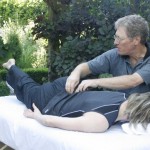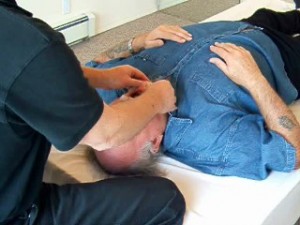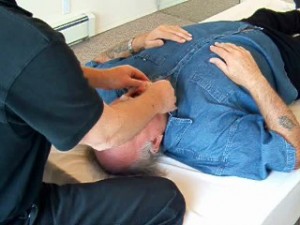The Diamond Penetration Technique is a way to get more done with less effort and less time, and more brainpower, in clinical sessions of Hanna somatic education(R) or with somatic exercises. The maneuver enhances or potentizes pandiculation (“Whole Body yawn”) technique.
There’s a lot, here, so as you learn this technique for “supersizing” somatic exercises, learn one step at a time before adding the next. “Learn” means “learn”, not “do once and then move one.” Really. Be merciful to yourself and take bite-size pieces, only.
In his original instruction to us, his students of his 1990 Clinical Somatic Education training, Thomas Hanna showed us how to use The Pandicular Response to free people from the grip of The Landau Reaction, which tightens the back/posterior side of the body and, when excessively activated for long periods of time, causes back pain, sciatica, tight shoulders and tension headaches.
In Lesson One (Green Light lesson) for Landau Reaction, he showed us how to coach our client through a Whole-body yawn (pandicular maneuver), beginning with a lifting action of one leg and its opposite shoulder, arm and hand, and head, as in the video, below — to lower them by stages in steps of relaxation, with a mini-in-breath with each mini-lift . . . . . before lowering some more.
First, the video, so you know for sure the maneuver to which I refer.

17 Minute First Aid for Back Pain
I have found that “staged” or “stepped” relaxation can be made more powerful by a technique that I have named, “The Diamond Penetration” maneuver. The reason I have named it The Diamond Penetration maneuver will become clear to you once you start doing it. For now, I say that it makes use of The Power of Recognition, as I have described it in the linked article, “Attention is a Catalyst“, to amplify the effectiveness of pandiculation, or any other therapeutic or educational technique, for that matter. Assisted Pandiculation is accelerated learning, and learning involves recognition and development, based upon memory. Memory, learning, recognition, function and development are five development stages of a single function. There’s one more.
Memory — the ground function, memory — persistence of pattern, memory
Learning — modification of the ground function into a durable pattern of memory
Recognition — the closely approximate match of some memory with an experience happening now
Function — initiation of action, memory activated and applied to this moment
Integration — facility to move freely and functionally among different remembered patterns
Evolution — expansion of attention beyond both memory and the moment — the space of emergence of newness, for patterns newly emerging into the moment, to be remembered into existence.
Take the starting initials of each, and you get MLRFIE! Well, that’s as far as we’ll go with that one, folks — at least for now. We’ll come back to that strange, unpronounceable acronym, later.
In his demonstrations to us, Thomas Hanna had the person on the table lower the leg part way, then lift a bit, then lower some more, repeating by stages, to complete rest. He even commented that that same maneuver was what Joe Montana did, spontaneously, after his back surgery and commented ruefully about to what the rapid improvement was attributed — namely, surgery and physical therapy!
Here’s the “inside” of that maneuver: The lifting action produces a sensation. By re-lifting after lowering part way, the client re-locates the sensation of lifting (contracting the muscles of lifting the leg). To re-locate the sensation activates the power of recognition, which is central to all learning. (No recognition — no learning.)
That’s the central principle of The Diamond Penetration Technique.
Here are the advantages of using The Diamond Penetration Technique. It:
- rapidly penetrates Sensory-Motor Amnesia
- rapidly awakens sensory awareness and motor control that has never been awake, before (penetrates Sensory-Motor Obliviousness)
- speeds integration of multiple “movement elements” into a single coordinated action
- increases the result of a single pandiculation — relaxation and control
- decreases the number of repetitions needed for pandiculation to get the desired result
- shortens the time needed to get a good result from a somatic exercise lesson
Obviously, these benefits are interrelated and just a tiny bit useful when working to transform yourself.
I have elaborated that principle into a very powerful technique that merits the name, “Diamond Penetration”. Very powerful. Clinical practitioners can apply this technique to assisted pandiculation maneuvers; clients can apply it to somatic exercises, and to free-form pandiculations you may do when working out pains or restrictions for which no somatic exercise currently exists.
I have developed several increasingly powerful variations of The Diamond Penetration Technique, which I outline, here.
- “The Quick Return”
- “The Quick Return and Sustained Hold”
- “The Two-Movement-Element Combination”
- “Twos and Threes”
- “The Diamond Pattern”
- “The Multi-Movement-Element Combination Sequence”
As you can see, these variations increase in complexity. The way to learn them is to do and learn them one-at-a-time, not to try to understand them by reading or to memorize them all before doing them.
Now the instruction. I’m going to spread things out in detail, so stay with me.
The Quick Return
Repetition is basic to recognition.
In The Quick Return, we contract into movement and feel the sensation of the end-point of movement (“where we end up in the movement”), then relax part-way for an instant, then re-contract and re-locate the exact same sensation.
- Contract and feel what’s tight.
- Relax part-way.
- Re-contract to feel the exact same thing.
That’s a Quick Return. It activates The Power of Recognition (familiarity). We might call each repetition “a pulse of sensation.”
An example from Lesson One could be,
“Lie on your belly, head turned, with your thumb in front of your nose, your hand flat on the surface. Lift your elbow to the limit. Feel what that feels like in your neck and shoulder.
Now lower it a bit, and immediately lift again. Find the exact same sensation at the same place. That’s called, ‘a Quick Return’. Remember that for use, as we go along.”
“Mini Quick Returns”
During the relaxation phase of pandiculation, you can do “mini” Quick Returns on the way to complete relaxation.
PRINCIPLE
It takes two incidents or occasions to activate memory; prior to that, it’s just sensory awareness or cognition — no recognition. In fact, without recognition, something happening is identical to nothing happening; we don’t know what it is, other than that it’s “something but we don’t really know what”, which makes the experience somewhat evanescent.
Now, the thing that makes one occurrence different from two occurrences of the same thing is the contrast between “happening” and “not happening”. “Not happening” has to separate the two occurrences. That’s the principle, “Somas perceive by contrast,” or “Somas can perceive only changes.” In somatic education practice, the common contrast is between activity and rest — which is why I instruct clients, “Come to complete rest between repetitions.” Without “not happening”, there’s only one long incident.
The Quick Return and Sustained Hold
We know that for a sensation to emerge, and for attention to steady on a sensation, takes time. Quick things escape our noticing.
So, after the Quick Return, we sustain the action (“sustained hold”) to let it “fade into view”. Attention steadies in and on the sensation. The sensation becomes more vivid.
To apply a sustained hold, you do a series of Quick Returns (however many) then hold the final Quick Return; during that holding time, remember the pattern and timing of the Quick Returns that got you there, i.e., brought you into this holding pattern. Then, you slowly relax, taking time at least equal in length to the memory . . . . . or longer . . . . to complete relaxation.
Thus, you
- first sense and do the movement, and hold, then
- remember the movement while holding its pattern, then
- back out (ease out) of the movement slowly and deliberately to complete rest.
You come to know the beginning of the movement, its middle, and its end — initiating it, sustaining it, and letting it go.
How useful do you think that might be for learning to occur?
The instruction would be:
“Do a Quick Return and hold. Now, slowly relax.”
PRINCIPLE
Experience takes time.
Sustain the hold for the total amount of time it took to do all the Quick Returns. For two Quick Returns (three movements into position), sustain the hold for a “count” of three — equal to the time it took to contract and then do two Quick Returns — then relax during a count of three. (That doesn’t mean, “Relax and then count to three.” It means, “Take a count of three to go from contracted to relaxed.”)
Comparing Memory to Action
Integrating the flesh-body and the subtle-body (mind).
Having done a Quick Return and Hold, you now remember the sensation of movement and then do the movement, again, to compare it to the memory. Are they the same?
You might then repeat the movement and compare to memory until the movement and the memory closely match.
PRINCIPLE
Memory is the root of action.
The Two-Movement-Element Combination
Coordination develops when we combine two actions (“movement elements”) into one.
In the Green Light lesson, we lift the elbow-hand-head-shoulder with the opposite-side leg, as in the video. Those are the two movement elements.
Using the Quick Return, the instruction could be:
- “With your hand flat on the surface, lift your elbow to the limit. Now do a Quick Return (relaxes and re-contracts) and hold.
- Now, lift your straight leg. Now lower it a bit, and do a Quick Return.
- Now, do a Quick Return of both, together.” (combination Quick Return)
When doing the Quick Return of both, together, the movements should be synchronized to start and end together. That develops coordination (integration).
HIGHER INTEGRATION
I have discovered another kind of “three” that rapidly integrates two movement elements. It goes beyond The Equalization Technique.
It goes like this.
Do a Quick Return of the first movement element and hold.
Do a Quick Return of the second movement element and hold.
Both movement elements are now active. Now, integrate them with each other in a three-part maneuver:
Pulse the first movement element to firm up the second movement element.
You’ll feel it. If you don’t feel it, you’ve partially lost the second movement element. Bring it back and pulse the first movement element, again, until you feel it make the second movement element stronger.
Pulse the second movement element to firm up the first movement element.
Pulse the first movement element to firm up the second movement element.
You’ve now forged a better connection between the two movement elements. That’s the other kind of “three” maneuver, an integration maneuver.
You can use this “three” maneuver with any two synergistic movements of any somatic exercise (“synergistic” means that the two movements help each other).
Twos and Threes
Now, we get a bit more sophisticated.
Once you or a client have done a combination Quick Return, you’re in a position to do two Quick Returns. That makes for, not two quick experiences of the same thing, but three.
If that’s confusing, lie on your belly with your thumb by your nose and do two Quick Returns. You’ll see it creates the same sensation three times. Just do it.
Here’s the thing: If, with a single movement, you alternate between one Quick Return (to complete relaxation) and two Quick Returns, you alternate creating two experiences of a sensation with creating three experiences. That’s a contrast, in itself.
When done as a combination Quick Return, it’s a very powerful way of creating learning that I have found causes a series of internal shifts of sensory-motor organization.
The instruction could be:
- Lift your elbow. Now do a Quick Return and hold.
- Lift your leg. Now do a Quick Return and hold.
(two movements at the same time) - Now, do two combination Quick Returns (a “three”). Relax completely.
- Now, do one combination Quick Return (a “two”). Relax completely.
- Alternate doing two and doing one. Continue until you get better coordinated.
PRINCIPLE
Changes of patterns awaken the Power of Recognition and trigger learning.
The Diamond Pattern
Here’s a “diamond” pattern (number of repetitions:
1 2 3 4 3 2 1
.
. .
. . .
. . . .
. . .
. .
.
The instruction could be:
- Do (some action, such as lifting the elbow) and hold. Now, relax completely.
- Do one Quick Return (2 experiences of a sensation) and hold. Now, relax completely.
- Now, do two Quick Returns (3 experiences of a sensation) and hold. Now, relax completely.
- Now, do three Quick Returns (4 experiences of a sensation) and hold. Now, relax completely.
- Now, do two Quick Returns (3 experiences of a sensation) and hold. Now, relax completely.
- Now, do one Quick Return (2 experiences of the sensation) and hold. Now, relax completely.
- Now, do the action without a Quick Return (1 experience of the sensation). Hold before relaxing to complete rest.
The experience “backs a person out of contraction” and gets them able to feel more and more with less and less stimulation.
To see the value, try it with any movement or combination.
PRINCIPLE
Bucky Fuller pointed out that four incidents or occasions of an event were the minimum needed to recognize a stable pattern.
It goes like this:
- one incident or occasion:
internal experience: “Something has happened.”|
(capture of attention) - two incidents or occasions of the same thing:
internal experience: “This seems familiar.”
(recognition) - three incidents or occasions of the same thing:
internal experience: “There seems to be consistency.”
(building upon recognition – “There is something to learn, here”) - four or more incidents or occasions of the same thing:
internal experience: “There’s a consistent pattern, here.”
(development of knowledge)
Test this out in yourself by using your imagination.
APPLICATION
The Diamond Penetration Technique can be applied to single movements, to simpler somatic exercise lessons (e.g., those of “The Cat Stretch” or “The New Seated Refreshment Exercises”), to more complex somatic exercises that involve as many as seven movement elements in combination (e.g., “Free Yourself from Back Pain” or “The Five-Pointed Star”), or to inherent action patterns such as those of walking (“SuperWalking”), twisting, or wriggling.
This technique lends itself to The Equalization Technique, discussed in The Evolution of Clinical Somatic Education Techniques. In a combination Quick Return, match (by feel) the effort of one movement to the effort of the others; equalize them. Read the article.
The Multi-Movement-Element Combination Sequence
In general, it goes like this:
- Do a Quick Return of the first movement element, and hold.
- Do a Quick Return of the second movement element, and hold.
- Do two combination Quick Returns of the two movement elements, and hold.
- Do a Quick Return of the third movement element.
- Do two combination Quick Returns of the three movement elements (with Equalization Technique).
- Do a Quick Return of the fourth movement element (if there is one).
- Do two combination Quick Returns of the four movement elements (with Equalization Technique).
Keep adding movement elements that fit together (synergistically) until they are all assembled into one Grand Coordinated Movement.
You can do Mini-Quick-Returns with the entire movement pattern, through the relaxation phase to complete rest.
Matching Memory (Subtle Body) to Sensation (Dense Physical Body)
Having done any of the variations, above, you can end a sequence by alternating a single quick return with a moment of rest (or a moment of holding the contraction), during which you remember (or imagine) and compare what you just felt with what you remembered.
You alternate a single quick return with remembering/imagining until your memory matches the experience very closely.
Then, you do a final contraction, hold and remember, then relax very, very slowly.
When the memory matches the experience, you have integrated your subtle and dense physical bodies. Relaxing at that point enables you to come out of contraction much more completely than otherwise.
PRINCIPLE
We perceive by means of contrast; we correct things by making a comparison. We gain control by means of memory.
SUMMARY
The essence of this technique involves repetitive pulsing of movements, activation of memory, matching the sensation you remember with the sensation you experience as you do the movements, and slow, controlled release of muscular efforts.
- Each pulse of movement creates a sensation that you locate as your “target” for Quick Return.
- In each repetition of a pulse, you locate the identical sensation in the identical location.
- In combination Quick Returns, you locate the identical feeling of the whole movement each time you do the combination movement.
- Each pattern of repetitions (2’s, 3’s, “diamond pattern”) magnifies the Power of Recognition.
Now you know what MRLFIE stands for!
I know there’s a lot. That’s why you start simply, at the beginning. Internalize (learn) each level of complexity until you have it all under your belt.
If you’re a practitioner, teach your clients to their capacity, but not beyond. If they lost the pattern, have them go back and coach them until they’ve mastered what you’ve covered, before going further.
COPYRIGHT 2011 Lawrence Gold ALL RIGHTS RESERVED
reproduction by permission, only


